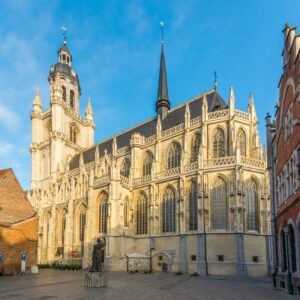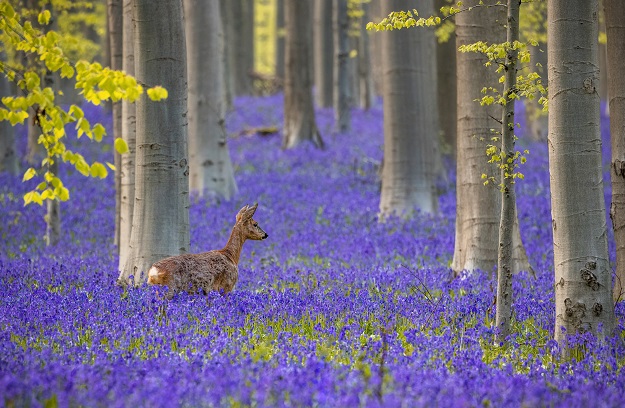For two weeks at the end of April, the Hallerbos forest southwest of Brussels is transformed into a dreamlike carpet of hovering bluebells.
Belgium is a country that wears its glories discreetly. Its people do not expect to be noticed, to garner international acclaim, nor lauded for their tourist attractions. Brussels is seen as a dull, corporate, bureaucratic place with little to offer the visitor.
While residents know this to be wholly false, a travel book in front of me casually dismisses the town as "seriously ugly" and with "fewer parks than any city I can think of." This seems a trifle harsh when it boasts 27 square miles of green space - including the mighty Foret de Soignes.
All this is to introduce a magical and ephemeral wood just a short train ride from the middle of Brussels. It is called the Hallerbos or, perhaps more poetically, the Blue Forest. Blue because, for two glorious weeks sometime towards the end of April, the entire wood becomes carpeted with bluebells.
Technically they are wild hyacinths, but no matter. It is difficult to describe just how exquisite the flowers are in the flesh, so to speak. Dabs of painterly blue cover the ground as though some psychedelic, impressionist madman had gone overboard with his lapis lazuli. The flowers appear when the ground is warm enough for them to grow but before the trees can deny them light. Hence the fleeting nature of the display.
Should you be tempted to make the trip it is fair to warn you what not to expect and what to expect. Do not expect easy parking, gift shops, restaurants, seats, bars, skateboard parks, easy wheelchair access or such. Parking is deliberately kept to a minimum to avoid too many visitors degrading the woods. If you go out at 14:00 on a weekend do not expect solitude - especially if it's sunny. Do not expect to wander off-piste nor (God forbid) to pick the flowers.
Do expect to be in a small forest (500 or so hectares, 1,250 acres) surrounded by farmland. Do expect the bluebell magic to have you reaching for your camera or phone (I am no expert, but for those who are I advise crouching low for the best effects). Do expect to dawdle so take something to eat and drink; but, of course, take away your litter.
Forest stumps
The forest itself is a remnant of the old Silvia Carbonaria where Frankish barbarians lay in wait for unsuspecting Roman legions. Stripped almost entirely by the occupiers in the First World War, it was re-afforested in the 1930s with oak, ash, larch and, incongruously, giant sequoias.
Populated by roe deer, foxes, the elusive polecat and countless birds, its size is increasing gently as the Flemish government purchases adjacent farmland and allows it to revert. Tree corridors are being created to nearby woods and dead trees are allowed to lie where they fall, all to boost biodiversity.

Hallerbos in Halle, renowned for its bluebells, Sunday 17 April 2022. BELGA PHOTO NICOLAS MAETERLINCK
The forest's legal protection has been increased of late to the status of a nature reserve, and there are plans to build an eco-bridge (animals only) to link up with the forests on the other side of the Brussels orbital motorway. All in all, Hallerbos seems in good hands.
If you go by public transport, then Halle itself is a mere 20 minutes from Brussels Central Station. There is a vast array of tickets in the machine: cheaper on weekends, for the over 65s, children, day returns, so choose well. They have English as an option.
When you reach Halle, just pick up the free shuttle bus outside the station; it runs every half hour up to the woods while the bluebells are doing their schtick. You will be deposited at one of the parking lots on the forest’s edge. Even if you're going by car on the weekend this might be an option; parking is a lot easier in Halle than up by the bluebells.
You can download a useful map, and garner other snippets on the Hallerbos website. The website should also publish when the flowers actually appear. If you decide to go to the woods off-season there is no shuttle bus but on weekdays bus 114 will take you pretty close. On the weekend and if you're fit you might want to consider hiring a bike. Taxis are also an option.
Halle, who goes there?
Should you choose to drive then be aware that on a busy, sunny weekend the local authorities might close off the narrow roads approaching the woods; or make some of them one way. When the road is blocked off there will normally be a shuttle bus provided. The argument for parking near Halle station becomes stronger. If, however, you go midweek, early in the morning, or late in the afternoon then Vlasmarktdreef Halle is the address you put in your satnav.
On your way back, whether by bus or car, consider spending a little time in Halle. The last train is at 23:35 (but do check!). The white sandstone Basilicum of St Martin on the Grote Markt is quite stunning.

Basilicum of St Martin
For reasons which escape academics and churchmen alike, almost uniquely in Belgium, it has never been looted. This in 600 years of marauding Austrians, French, Germans, Burgundians - the lot.
So, among Halle’s treasures is a statue of the Virgin from 1276, fonts dating from 1446, venerable stained glass à gogo, and a 15th century brass lectern; all of which should have been filched centuries ago. Then, having done your cultural duty, you can wander out into the Grote Markt and select a restaurant or bar.
None of them are tourist traps; Halle is a working city. Try hard not to address your waiter in French. Some don't mind, but some do. English is fine, Dutch is greatly appreciated.
The bluebells, on the other hand, are sublimely indifferent to linguistic quibbles.

